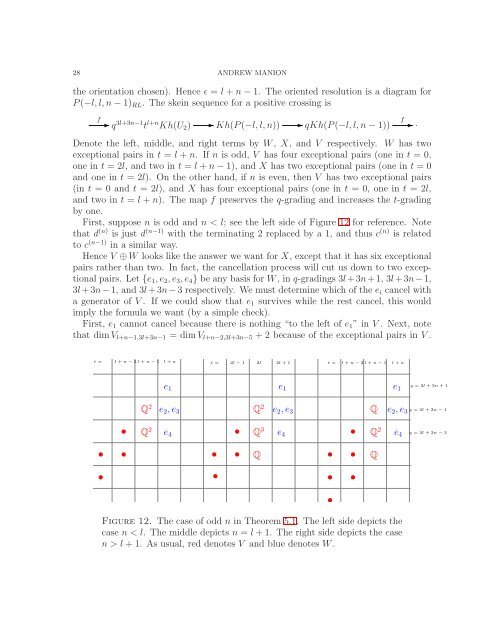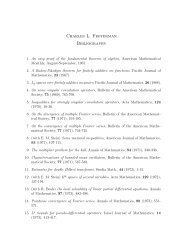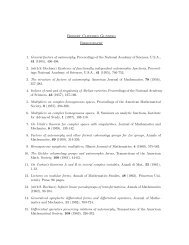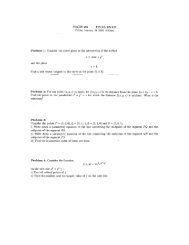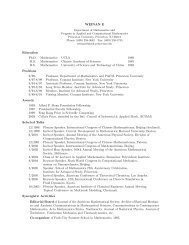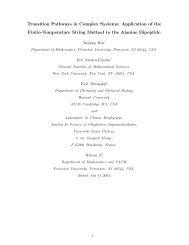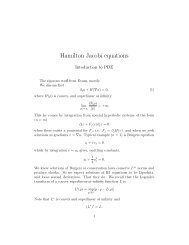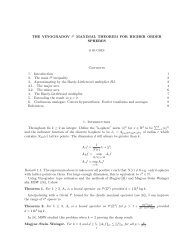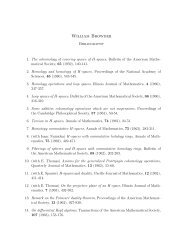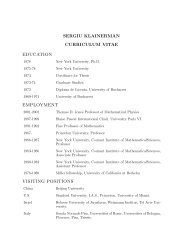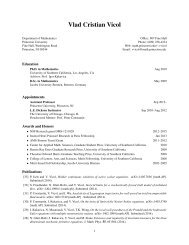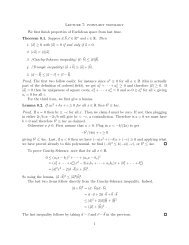The rational Khovanov homology of 3-strand pretzel links
The rational Khovanov homology of 3-strand pretzel links
The rational Khovanov homology of 3-strand pretzel links
You also want an ePaper? Increase the reach of your titles
YUMPU automatically turns print PDFs into web optimized ePapers that Google loves.
28 ANDREW MANION<br />
the orientation chosen). Hence ǫ = l + n − 1. <strong>The</strong> oriented resolution is a diagram for<br />
P(−l,l,n − 1) RL . <strong>The</strong> skein sequence for a positive crossing is<br />
f<br />
q 3l+3n−1 t l+n Kh(U 2 ) Kh(P(−l,l,n)) qKh(P(−l,l,n − 1))<br />
Denote the left, middle, and right terms by W, X, and V respectively. W has two<br />
exceptional pairs in t = l + n. If n is odd, V has four exceptional pairs (one in t = 0,<br />
one in t = 2l, and two in t = l + n − 1), and X has two exceptional pairs (one in t = 0<br />
and one in t = 2l). On the other hand, if n is even, then V has two exceptional pairs<br />
(in t = 0 and t = 2l), and X has four exceptional pairs (one in t = 0, one in t = 2l,<br />
and two in t = l + n). <strong>The</strong> map f preserves the q-grading and increases the t-grading<br />
by one.<br />
First, suppose n is odd and n < l; see the left side <strong>of</strong> Figure 12 for reference. Note<br />
that d (n) is just d (n−1) with the terminating 2 replaced by a 1, and thus c (n) is related<br />
to c (n−1) in a similar way.<br />
Hence V ⊕ W looks like the answer we want for X, except that it has six exceptional<br />
pairs rather than two. In fact, the cancellation process will cut us down to two exceptional<br />
pairs. Let {e 1 ,e 2 ,e 3 ,e 4 } be any basis for W, in q-gradings 3l+3n+1, 3l+3n−1,<br />
3l+3n −1, and 3l+3n −3 respectively. We must determine which <strong>of</strong> the e i cancel with<br />
a generator <strong>of</strong> V . If we could show that e 1 survives while the rest cancel, this would<br />
imply the formula we want (by a simple check).<br />
First, e 1 cannot cancel because there is nothing “to the left <strong>of</strong> e 1 ” in V . Next, note<br />
that dimV l+n−1,3l+3n−1 = dimV l+n−2,3l+3n−5 + 2 because <strong>of</strong> the exceptional pairs in V .<br />
f<br />
.<br />
t =<br />
l + n−2 l + n−1<br />
l + n<br />
t =<br />
2l−1 2l 2l + 1 t = l + n−2 l + n−1 l + n<br />
e 1<br />
e 1<br />
e 1<br />
q = 3l + 3n + 1<br />
Q 2<br />
e 2 ,e 3<br />
Q 2<br />
e 2 ,e 3<br />
Q<br />
e 2 ,e 3<br />
q = 3l + 3n−1<br />
Q 2<br />
e 4<br />
Q 3<br />
e 4<br />
Q 2 e 4<br />
q = 3l + 3n−3<br />
Q<br />
Q<br />
Figure 12. <strong>The</strong> case <strong>of</strong> odd n in <strong>The</strong>orem 5.1. <strong>The</strong> left side depicts the<br />
case n < l. <strong>The</strong> middle depicts n = l + 1. <strong>The</strong> right side depicts the case<br />
n > l + 1. As usual, red denotes V and blue denotes W.


